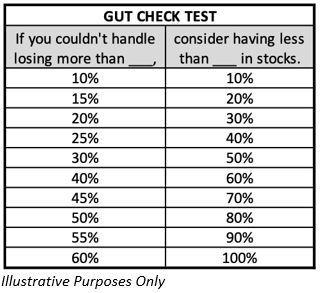May 28, 2021
You Can’t Get Outperformance Without Underperformance

Nobody minds market volatility when it’s in the upward direction. But recently we’ve gotten plenty of the type of volatility that we don’t like so much as investors, the kind that inspires headlines with words like “plunge” and that end with exclamation points.
It presents an opportunity, therefore, to remind ourselves of one of the central tenets of the art and science of investing: You can’t get outperformance without underperformance.
Indeed, the only reason we have a right to expect a higher rate of return on any given investment is that we’re willing to endure greater risk, and, in all likelihood, higher volatility. But just how much volatility?
Let’s look at some of the scariest market moments of the past 50 years, specifically how far the market—in this case, the S&P 500—dropped over a handful of notable time periods:

What you might find interesting, however, is just how quickly the market historically has recovered ground. It came roaring back so quickly that most of us have already forgotten our most recent crisis. After the oil embargo drawdown, it only took the market nine months to make investors whole. The Black Monday crash only required 14 months of patience, while the tech bubble recovery was slower at 40 months. Even in the worst of these recent market crises, the 2008 financial crisis, in which the market pulled back more than 50%, you only had to wait 26 months to get your money back.
But let’s be sure to put the word “only” in quotes—because if you saw your retirement nest egg of $1 million come crashing down to $447,000, my guess is that you were more than a little stressed out. In fact, I think it’s fair to suggest that most investors with “real money” on the line simply couldn’t handle that type of drawdown. Most would bail out. Maybe you did.
That’s why the most successful investors recognize that the best portfolio isn’t the one that has the potential to make the most money, but the one they can stick with for the long term. The goal isn’t squeaking out another percentage point or two of return over your lifetime while white-knuckling your smartphone, sweating over your investing app of choice, every time the reality of investing returns to claim its risk toll.
Instead, consider acknowledging this reality—and your own personal willingness to endure risk. Then offset the growth engine of your portfolio—your exposure to stock—with the stabilizing agent of the most conservative, boring fixed income or bonds. Consider the following gut check test, the goal being to match your maximum tolerable loss with an appropriate maximum equity exposure:

To use this simple guide most effectively, don’t try to imagine what a particular percentage loss would feel like; multiply the value of your investment portfolio today by the number on the left and use actual dollars. Even then, hypotheticals can be challenging, rarely drawing out the actual feelings we’re likely to endure in real life. So if you were invested in any of the crises listed above, ask yourself the question, “How did it feel to lose ___% of my portfolio back then?”
And when in doubt, err on the side of conservatism, because we tend to feel the pain of loss twice as strongly as the joy of gain—and because it feels better to miss out on a little upside than to bail out on an overly aggressive portfolio after losing a lot.
This article originally appeared May 16 on Forbes.com.
The opinions expressed by featured authors are their own and may not accurately reflect those of Buckingham Strategic Wealth®. This article is for general information only and is not intended to serve as specific financial, accounting or tax advice. Individuals should speak with qualified professionals based upon their individual circumstances. The analysis contained in this article may be based upon third-party information and may become outdated or otherwise superseded without notice. Third-party information is deemed to be reliable, but its accuracy and completeness cannot be guaranteed. Indices are not available for direct investment. Their performance does not reflect the expenses associated with the management of an actual portfolio nor do they represent the results of actual trading.
By clicking on any of the links above, you acknowledge that they are solely for your convenience, and do not necessarily imply any affiliations, sponsorships, endorsements or representations whatsoever by us regarding third-party websites. We are not responsible for the content, availability or privacy policies of these sites, and shall not be responsible or liable for any information, opinions, advice, products or services available on or through them. IRN-21-2181
© 2021 Buckingham Strategic Wealth®
